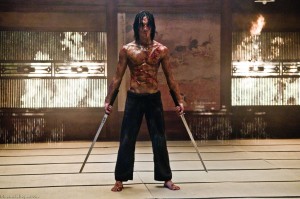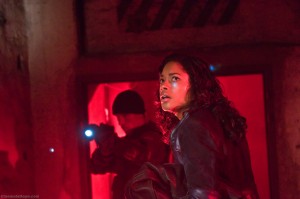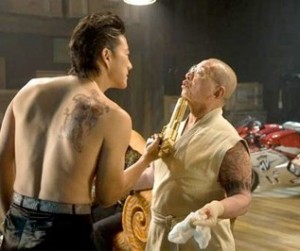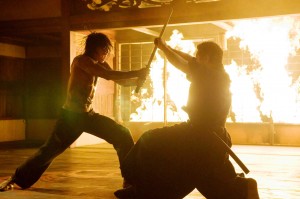Ninja Assassin
 The big-budget version of an exploitation movie is fool’s gold. Sure, the filmmaker who could have used some more money to make his action sequences more convincing or get more than one take of any given shot is a worthy cause. But there’s scrappy charm in low-budget films and you forgive the mistakes as part of the process and it ends up not mattering whether the movie was entertaining on purpose or not. When the same material is given $50 million, all of the story, structure, and character development problems become that much more glaring. James Cameron has always been a director who embraces the fact that he makes $200 million B-movies and he provides guilty pleasures in spades, but, much like with Michael Bay, when anyone speaks in his films, the clunk is practically audible. The dialogue often drags a scene in a movie like Transformers or Aliens to a complete halt, reducing the film to nothing more than an expensive special effects reel, filled in with characters that could have been written by hyperactive 9 year-olds on their summer break*.
The big-budget version of an exploitation movie is fool’s gold. Sure, the filmmaker who could have used some more money to make his action sequences more convincing or get more than one take of any given shot is a worthy cause. But there’s scrappy charm in low-budget films and you forgive the mistakes as part of the process and it ends up not mattering whether the movie was entertaining on purpose or not. When the same material is given $50 million, all of the story, structure, and character development problems become that much more glaring. James Cameron has always been a director who embraces the fact that he makes $200 million B-movies and he provides guilty pleasures in spades, but, much like with Michael Bay, when anyone speaks in his films, the clunk is practically audible. The dialogue often drags a scene in a movie like Transformers or Aliens to a complete halt, reducing the film to nothing more than an expensive special effects reel, filled in with characters that could have been written by hyperactive 9 year-olds on their summer break*.
 James McTeague’s Ninja Assassin is a prime example of what happens when someone gets the bright idea to throw money at the cheap, awkward and amusing ninja movies of the 1980s like Revenge of the Ninja and American Ninja. These movies featured immobile-faced actors like Michael Dudikoff and Shô Kosugi enacting revenge plots involving throwing stars, sword poses, and considering the only visible body part of a costumed ninja is his eyes, a lot of intimidating brow arching. McTeague brought along Kosugi to play the villain in Ninja Assassin** and the acting is about at the same level as a film like Pray For Death or Nine Deaths of the Ninja.
James McTeague’s Ninja Assassin is a prime example of what happens when someone gets the bright idea to throw money at the cheap, awkward and amusing ninja movies of the 1980s like Revenge of the Ninja and American Ninja. These movies featured immobile-faced actors like Michael Dudikoff and Shô Kosugi enacting revenge plots involving throwing stars, sword poses, and considering the only visible body part of a costumed ninja is his eyes, a lot of intimidating brow arching. McTeague brought along Kosugi to play the villain in Ninja Assassin** and the acting is about at the same level as a film like Pray For Death or Nine Deaths of the Ninja.
The opening scene is not a good omen; we get an old man tattooing gang members, as he talks about his scars and the great and powerful ninja who killed everyone in the room apart from him. The leader of the gang scoffs at the notion of a ninja, at which point the ninja starts killing his men, hiding in the shadows. The leader begs the ninja not to kill him, “whatever they’re paying you, I’ll pay double.”
 Since Ninja Assassin was produced by The Wachowski Brothers, the creators of The Matrix trilogy, groan-worthy dialogue like that is not a surprise (they did write the line “fasten your seat belt Dorothy, ’cause Kansas is going bye-bye”), but the introduction is all tonally wrong, especially considering what follows. All of the beheadings and flying body parts are done with CGI, distractingly so, and so quickly and darkly that there’s no time to savor the gratuitous gore. And the gang members don’t seem to realize they’re in a solemn, serious movie (well, intended as serious), so they play their scene as if they were in a low-rent mafia movie.
Since Ninja Assassin was produced by The Wachowski Brothers, the creators of The Matrix trilogy, groan-worthy dialogue like that is not a surprise (they did write the line “fasten your seat belt Dorothy, ’cause Kansas is going bye-bye”), but the introduction is all tonally wrong, especially considering what follows. All of the beheadings and flying body parts are done with CGI, distractingly so, and so quickly and darkly that there’s no time to savor the gratuitous gore. And the gang members don’t seem to realize they’re in a solemn, serious movie (well, intended as serious), so they play their scene as if they were in a low-rent mafia movie.
At least The Wachokskis were able to garner an R rating, so the ample carnage isn’t watered down, and they are certainly aided by the striking, angular cinematography by Karl Walter Lindenlaub. But the fact that Ninja Assassin is a studio film means that it never would have been allowed to be as outrageous as it needed to be, so compared to a completely insane over-the-top blood and guts fest like the independently produced Tokyo Gore Police, it’s relatively tame.
 Ninja Assassin gives us all the trademarks of its other producer, Joel Silver, and his company Dark Castle Entertainment. Silver got his break on films like Die Hard and Lethal Weapon, but he eventually developed a horror division within Warner Brothers, producing films like Gothika, and the remakes of House on Haunted Hill, Thirteen Ghosts, and House of Wax. What they all share, as does Ninja Assassin is terrific art direction, production design, a grating, blaring soundtrack, and way down the list of importance, quick pacing, coherence, and a competent level of acting. Scripts aren’t particularly relevant to this formula, so Ninja Assassin plays along by forgetting to have believable scenes or an actual story, since the movie is told almost entirely in awkward flashbacks.
Ninja Assassin gives us all the trademarks of its other producer, Joel Silver, and his company Dark Castle Entertainment. Silver got his break on films like Die Hard and Lethal Weapon, but he eventually developed a horror division within Warner Brothers, producing films like Gothika, and the remakes of House on Haunted Hill, Thirteen Ghosts, and House of Wax. What they all share, as does Ninja Assassin is terrific art direction, production design, a grating, blaring soundtrack, and way down the list of importance, quick pacing, coherence, and a competent level of acting. Scripts aren’t particularly relevant to this formula, so Ninja Assassin plays along by forgetting to have believable scenes or an actual story, since the movie is told almost entirely in awkward flashbacks.
 The construction of the story takes up, depending on your point-of-view, far too much or too little screen time***, since the basic plot is; a female British researcher within a tight-lipped government agency discovers the existence of ninjas. And then they try to kill her. That’s it. The only way she stays alive is that Korean pop-star Rain, who defected from the same ninjas who are after her, gets in the way and dispatches whomever attacks. While we get Rain’s entire back-story, he’s an orphan raised amongst other orphans in Japan, in a secret ninja training facility (some of the kids are white, I’m not sure why), it’s all a bunch of unnecessary clichés that could have been summed up in five minutes, along with his unconvincing romance with a rebellious female he trains with. No one came to Ninja Assassin to see 75% of the movie consumed with exposition, but we barely get to see anything else anyway, it’s all dark CGI shadows and fights edited to look like Anime (the third Matrix film had a similar anime look to it). We don’t even get to learn what the limits of ninjadom are; they appear to be able to heal themselves, when they remember to (as if they were wizards but with short term memory problems), and they can fly around at will, but if we don’t know the rules, there’s not much at stake in a battle. If during a fight, Rain had suddenly tripled in size and started breathing fire, it would have been just as palatable. Actually, why isn’t that scene in Ninja Assassin?
The construction of the story takes up, depending on your point-of-view, far too much or too little screen time***, since the basic plot is; a female British researcher within a tight-lipped government agency discovers the existence of ninjas. And then they try to kill her. That’s it. The only way she stays alive is that Korean pop-star Rain, who defected from the same ninjas who are after her, gets in the way and dispatches whomever attacks. While we get Rain’s entire back-story, he’s an orphan raised amongst other orphans in Japan, in a secret ninja training facility (some of the kids are white, I’m not sure why), it’s all a bunch of unnecessary clichés that could have been summed up in five minutes, along with his unconvincing romance with a rebellious female he trains with. No one came to Ninja Assassin to see 75% of the movie consumed with exposition, but we barely get to see anything else anyway, it’s all dark CGI shadows and fights edited to look like Anime (the third Matrix film had a similar anime look to it). We don’t even get to learn what the limits of ninjadom are; they appear to be able to heal themselves, when they remember to (as if they were wizards but with short term memory problems), and they can fly around at will, but if we don’t know the rules, there’s not much at stake in a battle. If during a fight, Rain had suddenly tripled in size and started breathing fire, it would have been just as palatable. Actually, why isn’t that scene in Ninja Assassin?
* Much like Robert Rodriguez’s kids films, like Sharkboy and Lava Girl, which are literally written by nine-year olds and are otherwise bright and colorful effects reels.
** Like Black Dynamite, Ninja Assassin is a genre parody, faithful to the hilt, but without the laughs. Except that in Ninja Assassin no one seems aware that they’re in a terrible film.
*** The movie needed to be either way, way over-the-top or relatively restrained. On the Kinsey scale of ninja violence, Ninja Assassin is about a 7, when anything less than a 10 is unacceptable.



